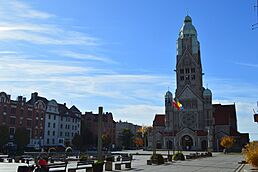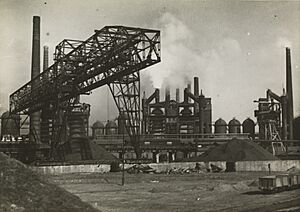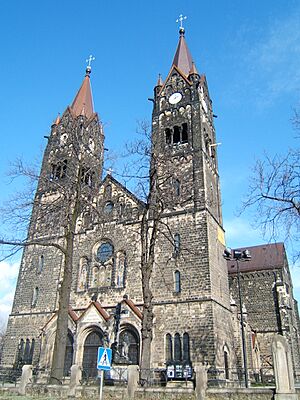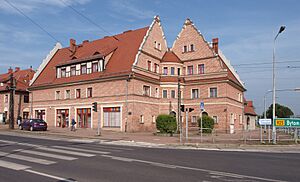Ruda Śląska facts for kids
Quick facts for kids
Ruda Śląska
|
|||||
|---|---|---|---|---|---|
|
County
|
|||||
|
From top, left to right: Main square with the St. Paul the Apostle Church, Wawel Community Centre, Niedurnego Street
|
|||||
|
|||||
| Country | |||||
| Voivodeship | |||||
| County | city county | ||||
| Established | 13th century | ||||
| Town rights | 1959 | ||||
| Area | |||||
| • County | 77.73 km2 (30.01 sq mi) | ||||
| Highest elevation | 321 m (1,053 ft) | ||||
| Lowest elevation | 225 m (738 ft) | ||||
| Population
(31 December 2021)
|
|||||
| • County | 135,008 |
||||
| • Density | 1,760/km2 (4,600/sq mi) | ||||
| • Urban | 2,746,000 | ||||
| • Metro | 4,620,624 | ||||
| Time zone | UTC+1 (CET) | ||||
| • Summer (DST) | UTC+2 (CEST) | ||||
| Postal code |
41–700 to 41–718
|
||||
| Area code(s) | +48 32 | ||||
| Car plates | SRS, SL | ||||
| Primary airport | Katowice Airport | ||||
| Website | http://www.rudaslaska.pl/ | ||||
Ruda Śląska is a city in southern Poland, close to Katowice. It is part of a very large urban area called the Metropolis GZM, which has over two million people. The city is located in the Silesian Highlands, near the Kłodnica River.
Ruda Śląska has been part of the Silesian Voivodeship since 1999. Before that, it was in the Katowice Voivodeship. The city is home to about 135,000 people (as of December 2021).
Contents
Discovering Ruda Śląska's Past
A large village existed here as early as 1243. The name "Ruda" suggests that people knew about and perhaps mined ores in the area a long time ago.
In the 1800s and early 1900s, the area grew quickly with many factories. Coal mining, steel production, and zinc factories were very important. However, Ruda Śląska was not one big city. It was a group of industrial towns and villages until the 1950s, when they were all joined together.
Ruda Śląska During World War II
Before World War II began in 1939, there was an attack by German saboteurs in Ruda. During the war, from 1939 to 1945, the area was under German control. Many Polish teachers from Ruda Śląska were killed by the Germans during this time. The Germans also set up forced labor camps for Poles in the areas of Kochłowice and Chebzie. Polish resistance groups were active in the area. In 1945, the German control ended, and the area became part of Poland again.
Modern Changes and Growth
| Historical population | ||
|---|---|---|
| Year | Pop. | ±% |
| 1950 | 33,962 | — |
| 1960 | 131,667 | +287.7% |
| 1970 | 143,122 | +8.7% |
| 1980 | 159,097 | +11.2% |
| 1990 | 171,034 | +7.5% |
| 2000 | 152,280 | −11.0% |
| 2010 | 142,950 | −6.1% |
| 2020 | 136,423 | −4.6% |
| source | ||
After 1989, when communism ended in Poland, many of the big factories either closed or changed. The city began to focus more on services instead of heavy industry. One well-known coal mine, "Halemba," is still working today.
Since 2007, Ruda Śląska has been a member of the Upper Silesian Metropolitan Union. This is the largest official urban area in Poland.
Getting Around Ruda Śląska
The city has important roads like Highway A4 and the Drogowa Trasa Średnicowa. There are also several small railway stations, mainly on the train line between Katowice and Gliwice.
Since 1950, Ruda Śląska has been home to a special facility for sending out radio signals. It was used for medium-wave radio broadcasting until 1988.
Learning in Ruda Śląska
While the nearby cities of Katowice and Gliwice have many universities, Ruda Śląska also has its own place for higher learning. It is home to the Higher Academy of Commerce (Wyższa Szkoła Handlowa).
Sports and Fun in Ruda Śląska
Ruda Śląska is home to several sports teams:
- Zgoda Ruda Śląska – This is a women's handball team that plays in Poland's top league.
- Rugby Club IGLOO Ruda Śląska – This is a men's rugby team that plays in the Polish Ekstraliga Rugby Seven's league.
Parts of Ruda Śląska
The city of Ruda Śląska is made up of several smaller areas, like neighborhoods or districts. These include:
|
 |
Famous People from Ruda Śląska
Many talented people have come from Ruda Śląska, including:
- Karl Godulla (1781–1848), an important industrialist.
- Günter Bialas (1907–1995), a German composer.
- Ernest Pohl (1932–1995), a famous footballer.
- Otylia Jędrzejczak (born 1983), an Olympic gold medalist and world record-holder in swimming.
- Kasia Moś (born 1987), a singer and songwriter who represented Poland in the Eurovision Song Contest 2017.
- Many footballers like Paweł Cyganek, Erwin Wilczek, Marcin Baszczynski, Artur Sobiech, Kamil Grabara, and Mateusz Bogusz.
- Athlete Marek Plawgo (born 1981).
Did you know? Ruda Śląska is the largest city in Poland that has never been visited by Lech Wałęsa, a famous former Polish president. There's even a special plaque on the town hall to show this!
Ruda Śląska's Sister Cities
Ruda Śląska has special friendships with other cities around the world. These are called "sister cities":
 Carrickfergus, Northern Ireland, United Kingdom
Carrickfergus, Northern Ireland, United Kingdom Levice, Slovakia
Levice, Slovakia Mank, Austria
Mank, Austria Vibo Valentia, Italy
Vibo Valentia, Italy
Images for kids
See also
 In Spanish: Ruda Śląska para niños
In Spanish: Ruda Śląska para niños










